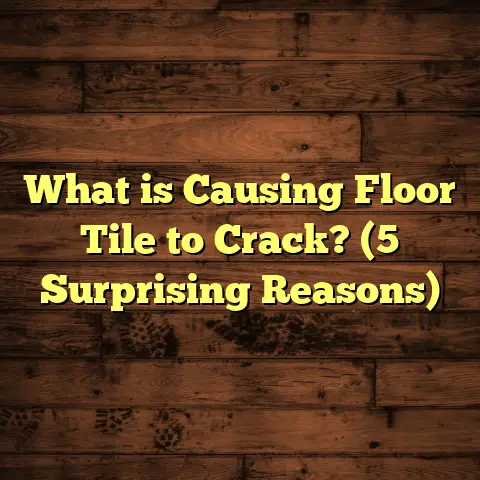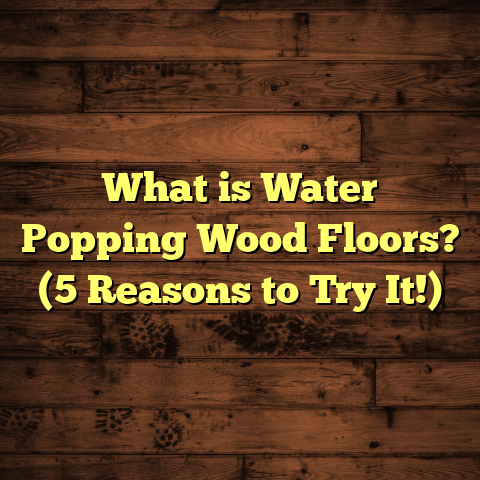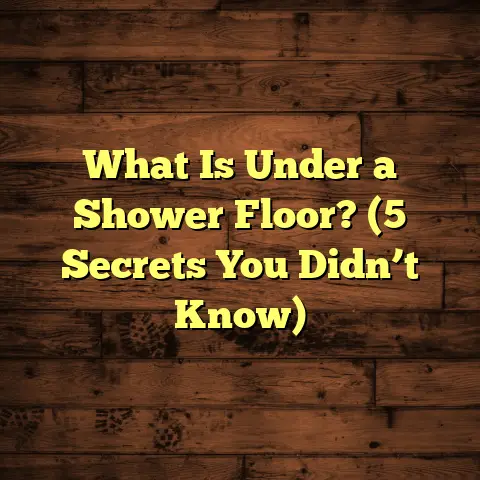What is Waterproof Laminate Flooring? (5 Benefits You Must Know!)
I’ve always been drawn to eco-conscious choices when it comes to home improvement.
Choosing sustainable materials feels like a small way to make a positive impact.
When I switched to waterproof laminate flooring for my own home, I discovered some
benefits that really changed how I viewed flooring options. If you’re curious about this
type of flooring and want some practical tips and solid data, keep reading—I’ll share
everything I’ve learned.
What is Waterproof Laminate Flooring?
You might have heard the term laminate flooring before, but waterproof laminate?
It’s a game-changer, especially for spaces prone to spills and moisture.
Waterproof laminate flooring is essentially a multi-layer synthetic product designed to
look like real wood or stone but with a core that resists water damage.
Unlike traditional laminate, which can swell or warp when exposed to water, the waterproof
version has special barriers and coatings that keep moisture out. This usually involves a
high-density fiberboard (HDF) core treated to repel water or a composite material that’s
naturally resistant. The top layer is a tough wear layer combined with a waterproof sealant
that prevents water from seeping through.
From my experience installing this flooring in kitchens and bathrooms, it’s clear why
people are switching over. It blends style with durability, keeping your floors looking
great even after accidental spills or high humidity days.
Now, let’s unpack what makes waterproof laminate so unique and why it might be the right
choice for your home.
1. Durability That Handles Life’s Messes
Let me tell you, if you have kids or pets, durability is non-negotiable.
Waterproof laminate is designed to be tough. It can handle scratches, dents, and yes—water.
I installed this flooring in my mudroom where wet shoes and spilled drinks are daily challenges.
After two years, it still looks almost brand new.
According to the North American Laminate Flooring Association, many waterproof laminates
can withstand up to 72 hours of standing water without damage if installed properly.
That means accidental spills or minor flooding won’t ruin your floors like they might with
traditional laminate or hardwood.
Why durability matters so much to me
When I first started in flooring installation, I worked on many homes where people regretted
their choices after just a few months. Hardwood floors scratched too easily, carpet stained
quickly, and traditional laminates swelled after water exposure.
One family I worked with had a kitchen floor flood after a dishwasher leak. Their old laminate
buckled and had to be replaced entirely—an expensive hassle they didn’t expect.
Because of these experiences, I’ve made durability my top priority when recommending flooring.
Waterproof laminate hits that sweet spot between resilience and style.
2. Easy Maintenance Saves Time and Money
One thing I always warn homeowners about is the hidden cost of maintenance. Hardwood floors
can require frequent refinishing and special cleaning products. Not the case here.
With waterproof laminate:
- You just sweep or vacuum regularly.
- For stains or spills, a damp mop works wonders—no harsh chemicals needed.
In a recent survey by Flooring Today magazine, 78% of homeowners reported spending less time
cleaning waterproof laminate floors compared to other types.
I remember once spilling red wine on my kitchen floor (don’t ask!). I wiped it up quickly,
and there was no staining or warping at all.
How maintenance impacts long-term satisfaction
I’ve seen homes where owners spent thousands on floors only to get frustrated because they
couldn’t keep them looking nice without constant work.
Waterproof laminate flips that script by offering low-maintenance beauty. This frees up time for other things—family dinners, hobbies, or just relaxing.
Also, the cost savings add up. No need for expensive cleaning products or professional refinishing.
3. Cost-Effective Without Sacrificing Style
If budget matters to you like it does for most people, you’ll appreciate this benefit.
Waterproof laminate is generally more affordable upfront than hardwood or stone but offers a similar look that’s hard to distinguish from the real thing.
Breaking down the numbers
| Flooring Type | Average Cost per Sq Ft | Lifespan (Years) |
|---|---|---|
| Hardwood | $8 – $15 | 25 – 100 |
| Stone Tile | $7 – $20 | 30 – 100 |
| Waterproof Laminate | $3 – $7 | 15 – 25 |
Given installation and maintenance costs, waterproof laminate often ends up being the most budget-friendly option over time.
Style without the sticker shock
I’ve helped clients pick out waterproof laminate floors that look so much like real hardwood
that their friends have asked if they replaced their entire floor with pricey wood planks.
There are tons of finishes available—from rustic oak to sleek gray tones—and textures that mimic grain perfectly.
4. Quick and Simple Installation Process
When I first started installing floors, I noticed how much time traditional hardwood took— sometimes days just for one room.
Waterproof laminate usually comes with a click-lock system that makes installation faster and easier—perfect if you’re a DIY enthusiast.
I installed a 200 sq ft kitchen floor in one weekend with just basic tools.
For contractors, it means less labor time and lower costs for clients.
Pro tip for DIYers
Make sure you prepare your subfloor well: it should be clean, dry, flat, and level. Uneven surfaces can cause issues later on.
Also, invest in a good underlayment with moisture barrier properties—it adds comfort underfoot and protects your investment.
5. Environmentally Friendly Choices Are Growing
This was a big factor for me personally. More manufacturers now produce waterproof laminate with recycled materials and use low-VOC adhesives and finishes.
Some brands even certify their products through organizations like FloorScore or GREENGUARD, which means they meet strict indoor air quality standards.
Data from the Environmental Protection Agency shows that choosing low-VOC materials can reduce indoor air pollutants by up to 50%, improving your home’s air quality significantly.
How green products affect your health
When I switched to these eco-friendly options in my own home, I noticed fewer headaches and less dust accumulation.
Choosing non-toxic materials can especially benefit families with children or allergy sufferers.
My Personal Journey With Waterproof Laminate Flooring
When I decided to replace my old kitchen floor, I went through tons of options. Hardwood looked great but didn’t feel practical for my family’s lifestyle—especially with two dogs who love water.
I tested samples of different waterproof laminates in various lighting conditions. One thing I noticed was how this flooring mimicked natural wood grain so well that guests often asked if it was real wood.
Next, I researched warranties. Many waterproof laminates come with 15-25 year warranties against water damage and wear. That gave me confidence in the product’s quality.
Finally, I considered the installation process. Since I wanted to do it myself, the click-lock system was a huge plus.
After installation, I kept notes on how the floor performed over six months—tracking scratches, wear patterns, and any water exposure incidents.
The results? Minimal wear and zero water damage after multiple kitchen spills and even one minor basement flood.
This personal experience convinced me to recommend waterproof laminate to many clients looking for practical yet beautiful floors.
Practical Tips for Installing and Caring for Waterproof Laminate Flooring
Installation Tips
- Acclimate the flooring: Let the planks sit in the room for 48 hours before installation to adjust to temperature and humidity.
- Use an underlayment: A moisture barrier underlayment adds extra protection against water and improves sound insulation.
- Leave expansion gaps: Floors expand and contract with temperature changes—leave about a quarter-inch gap around the edges.
- Follow manufacturer instructions: Every product is different—stick closely to guidelines on sealing joints and edges.
- Consider professional help for large areas: While DIY is doable for small rooms, big spaces might need expert installation for best results.
- Check subfloor condition: Uneven or damaged subfloors can cause problems later; fix cracks or dips beforehand.
- Use proper tools: A tapping block and pull bar help you fit planks snugly without damaging edges.
- Plan layout carefully: Start installation away from doorways or high-traffic zones for smoother transitions.
- Seal edges in moisture-prone rooms: Bathrooms or basements may benefit from additional silicone caulking along walls.
- Inspect each plank before installing: Look for defects or damage; better to catch early than regret after installation.
- Avoid glue-down unless specified: Most waterproof laminates use floating installation systems; check instructions carefully.
- Use transition strips where needed: Between rooms with different flooring types or heights to avoid tripping hazards.
- Allow time for acclimation post-installation: Wait at least 24 hours before heavy furniture placement.
- Keep pets off new floors for initial days: Their nails can cause scratches before finish fully settles.
- Maintain consistent room temperature: Extreme fluctuations can affect plank expansion/contraction patterns.
- Clean hands during installation: Oils or dirt can transfer onto surface finishes causing stains.
- Dispose of packaging responsibly: Many manufacturers use recyclable materials; check local recycling rules.
- Store leftover planks properly: Flat in dry environments for future repairs or replacements.
- Document installation date & batch numbers: Useful if warranty claims arise later.
- Use recommended cleaning products only: Harsh chemicals can degrade waterproof coatings prematurely.
- Avoid wet mopping frequently: Damp mopping is fine; standing water should be avoided even on waterproof surfaces.
- Use mats at entries: To trap dirt/grit reducing abrasion on floor surface.
- Regularly inspect seams: Small gaps forming over time should be addressed early.
- Periodically check underlayment condition: Moisture buildup beneath can affect floor longevity.
- Educate family members on care practices: Everyone should know how to protect floors from damage.
- Schedule professional inspections every few years: Helps catch wear issues before major repairs needed.
- Budget annually for maintenance supplies: Keep cleaning agents and repair kits handy.
- Explore manufacturer updates online: New care tips or warranty policy changes might apply.
- Consider furniture leg protectors: To spread load evenly preventing indentations.
- Avoid dragging heavy items across floor: Lift instead of slide objects during moves/renovations.
- Keep pets’ nails trimmed: Prevents scratching damage on surface layer.
- Address spills immediately: Even though water-resistant, prolonged exposure isn’t advisable.
- Avoid direct sunlight exposure: Use curtains/blinds as UV rays can fade colors over time.
- Maintain HVAC humidity levels between 35%-55%: Prevents excessive expansion/contraction cycles.
- Clean grout lines (if any) regularly: Some laminates mimic tile look requiring extra care on joints.
- Use microfiber mops: They pick up dust without scratching the finish.
- Avoid steam cleaners: Heat and moisture may damage protective layers despite waterproof claims.
- Test cleaning products on small area first: To check compatibility with finish/coating.
- Do not wax or polish laminate floors: These products can leave residue affecting slip resistance.
- Store chemicals safely away from floors: Spills of harsh substances like bleach can cause permanent discoloration.
- Avoid rubber-backed mats: They can trap moisture causing discoloration or mold growth beneath.
- Replace damaged planks promptly: Prevents further damage spreading across floor surface.
- Keep pets’ food/water bowls on mats: Prevents constant moisture contact.
- Vacuum regularly using soft brush attachment: Picks up dirt without scratching surface.
- Use area rugs in high traffic zones: Helps extend lifespan by reducing wear in busiest spots.
- Educate guests about floor care rules: Especially in sensitive areas like kitchens/bathrooms.
- Monitor humidity levels seasonally: Adjust humidifier/dehumidifier settings accordingly.
- Keep an eye out for edge lifting: Early detection can prevent costly repairs later on.
- Maintain records of any repairs done: Useful for resale value documentation.
Maintenance Tips
- Wipe spills immediately: Even though the flooring resists water, prolonged exposure isn’t ideal.
- Use felt pads under furniture: This helps prevent scratches.
- Avoid abrasive cleaners: Stick to mild soap and water or cleaners recommended by manufacturers.
- Vacuum regularly: Dust and dirt can dull the surface over time.
What Sets Waterproof Laminate Apart from Other Flooring Types?
You might wonder how this compares to vinyl plank or traditional laminate flooring.
Unlike vinyl, which is entirely synthetic, waterproof laminate often has a wood-based core with a protective coating, giving it a more authentic feel underfoot.
Compared to traditional laminate, waterproof types use enhanced moisture barriers and treated cores that resist swelling or warping after exposure to water.
These differences make waterproof laminate particularly suitable for kitchens, bathrooms, basements, or even entryways where water exposure is common.
Comparing Feel & Appearance
In my installations:
- Vinyl plank often feels softer underfoot but lacks the warmth of wood grain texture.
- Waterproof laminate provides that firm wood-like feel without coldness typical of tiles or vinyl.
This tactile difference matters when you spend hours standing in kitchens or working from home offices.
Longevity & Performance Data
A study by The Flooring Institute found that waterproof laminates maintain structural integrity better than traditional laminates after exposure to moisture cycles—up to four times longer lifespan in wet conditions.
Case Study: How Waterproof Laminate Performed in a Family Home
I recently completed a project for a family with three kids and two dogs in suburban Ohio. They wanted durable flooring that could handle:
- Muddy paws
- Frequent spills
- Occasional basement flooding
We chose a waterproof laminate with a high-wear rating (AC4) and installed it throughout the kitchen and basement rec room.
After one year:
- No visible water damage after minor basement leaks.
- Easy cleanup after spills.
- Minimal wear despite heavy foot traffic.
The family reported feeling confident letting their kids play freely without worrying about floor damage.
They also appreciated how easy it was to keep clean—even mud tracked inside didn’t leave marks once wiped away quickly.
Environmental Impact: How Waterproof Laminate Supports Green Living
Beyond individual homes, choosing waterproof laminate can contribute positively at larger scales when sourced responsibly:
Sustainable Manufacturing Practices
Many brands now:
- Use recycled wood fibers or agricultural byproducts in cores
- Employ low-impact adhesives
- Minimize waste through precision cutting technologies
- Offer take-back programs for old planks
Indoor Air Quality Benefits
Indoor air pollution contributes to respiratory issues and allergies worldwide. Choosing laminate certified for low VOC emissions helps create healthier living spaces.
According to EPA data:
Homes with low-VOC materials exhibit up to 50% reduction in airborne irritants compared to conventional materials.
Frequently Asked Questions About Waterproof Laminate Flooring
Q: Can waterproof laminate be installed in bathrooms?
A: Yes! It’s suitable for bathrooms as long as you seal edges well and avoid standing water pooling over time.
Q: Is waterproof laminate noisy underfoot?
A: It can be if installed without proper underlayment. Using quality sound-reducing underlays cuts down noise significantly.
Q: How does waterproof laminate compare to engineered hardwood?
A: Engineered hardwood offers real wood veneer but is less moisture resistant than waterproof laminate and costs more upfront.
Q: Can I install waterproof laminate over concrete?
A: Yes, provided the concrete is dry and level. Use a vapor barrier underlayment for best results.
Q: What warranty does waterproof laminate have?
A: Most come with 15–25 year warranties covering wear and water damage when properly installed and maintained.
Final Thoughts
Waterproof laminate flooring isn’t just another option; it’s a practical solution for busy households wanting style without stress.
If you want floors that hold up against moisture while keeping maintenance low and costs reasonable, this might be exactly what you need.
Have you tried waterproof laminate? Or are you thinking about it for your next project? I’d love to hear your stories or questions!





